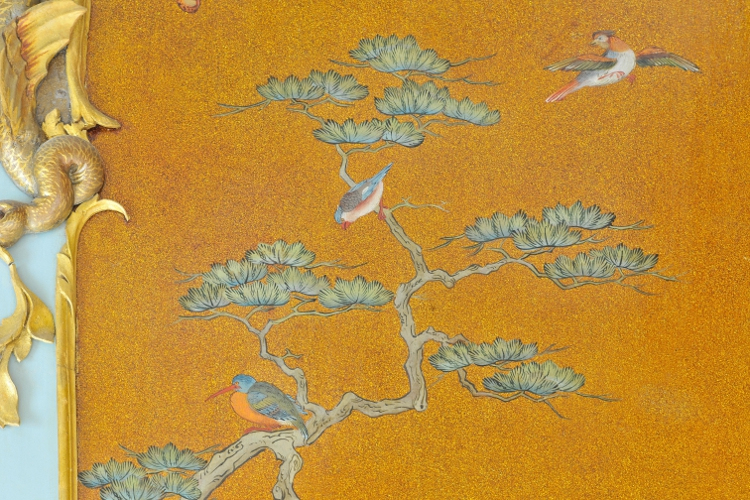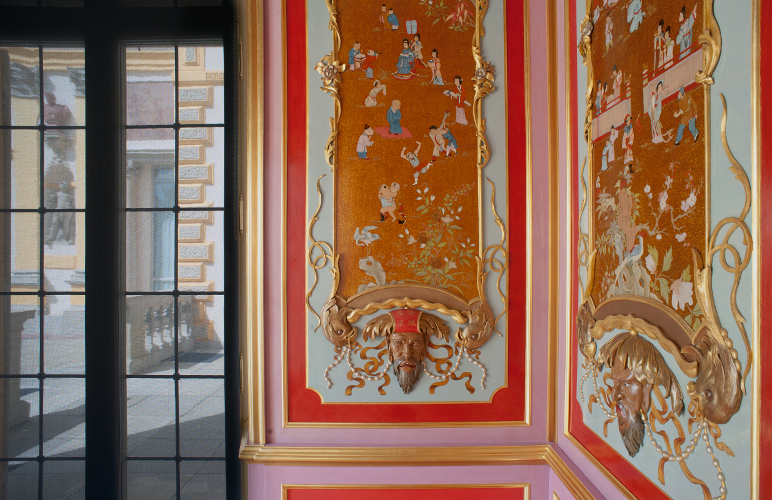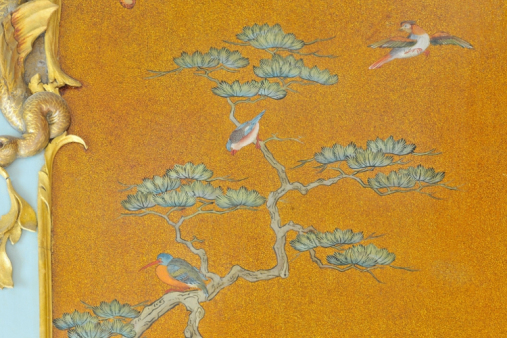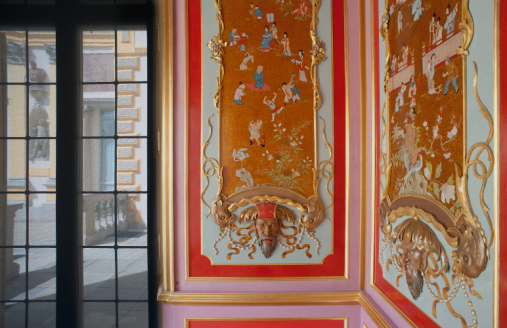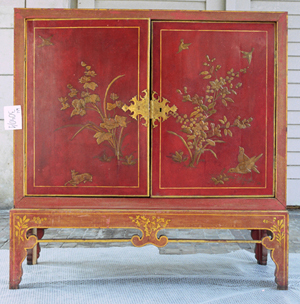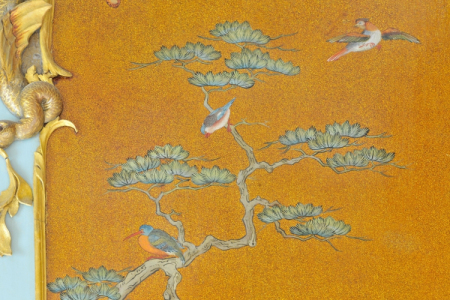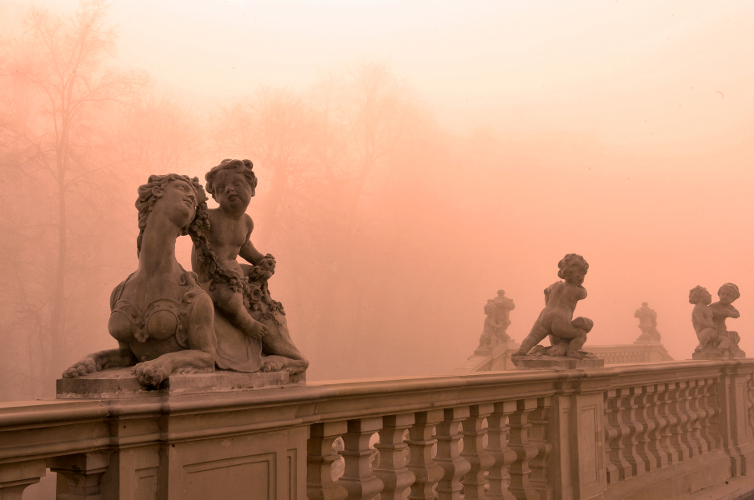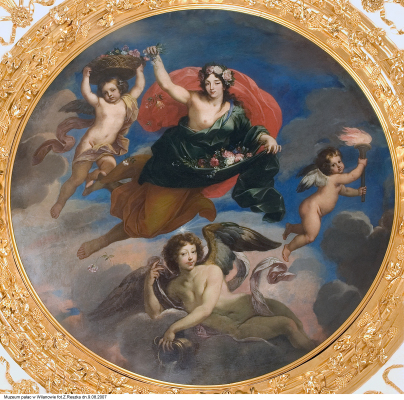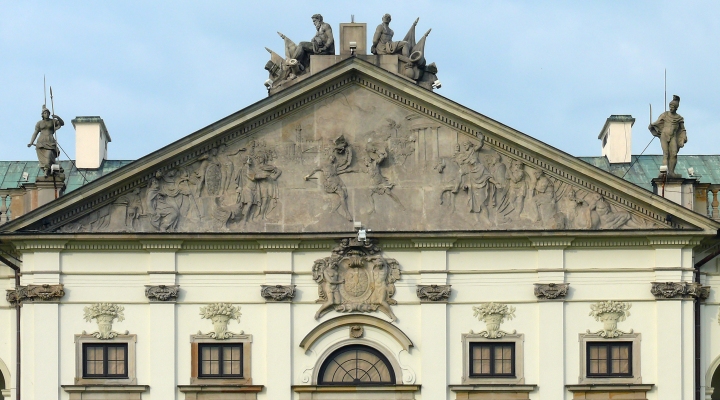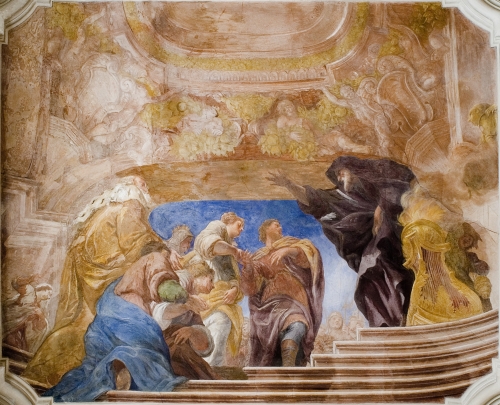Martin Schnell (1675?–1740?)
Martin Schnell (1675?–1740?) - Photo gallery - Element slider
Martin Schnell (1675?–1740?) - Photo gallery - Element slider
One of the greatest masters of European lacquer art — a part of a broader range of art in chinois style developed in early eighteenth century, mostly in Northern Europe — was Martin Schnell, a servitor at Augustus II the Strong’s court of artists in Dresden. His works had also travelled to the Commonwealth, primarily to a range of royal and magnate residences in Warsaw.
Lacquer, a medium known to China and Japan for hundreds of years, made from resins of particular types of trees, was applied for decorative purposes to the surfaces of products of artistic crafts (mostly wood and plaster). At the turn of the eighteenth century, the technology rapidly achieved a level of popularity in the West — marked by steeply rising prices and a high demand among European collectors — that prompted the devising of an imitation known as pseudo-lacquer. The European technology relied on fresh and fossil resins of different origin, melted and dissolved in ethyl alcohol and oils. Black (later also red and green) lacquer surfaces were embellished with silver, gold, and paint. They were typified by an elegant sheen as well as transparency, resulting in an inimitable, unusual depth effect. Objects were adorned with motifs directly imitating Far Easterns originals or using them as a more or less literal inspiration. The greatest masters of European lacquer art, known as lacquerers (Lakierer or Laquirer in German, lakier in Old Polish), knew how to achieve results of surprising proximity to the formidable Chinese and Japanese prototypes. In Europe, lacquer was applied not only to furniture, but also to parts of interior decorations, such as tapestries, wainscotting, wood-carvings, as well as plasterworks or products of the newly-established ceramic technologies: stoneware and early porcelain.
Neither the date nor the place of birth of Martin Schnell is known. Before the war, Rudolf von Arps-Aubert, author of a monograph on the Saxon artist, came up with the year 1675 and the town of Stabe on the Elbe in Saxony without citing any particular archival sources, but neither information was verified since. The first definite mention of Schnell dates back only to 1710, when the artist received the title of Hofflacquirer from Augustus II in Dresden. It is surmised that the monarch had met Schnell already during the Great Northern War, in 1703 in Malbork.
Schnell probably became acquainted with lacquer art at the turn of the eighteenth century at the Berlin court of Frederick I, King of Prussia, where famous European lacquerers — the brothers Gérard and Jacques Dagly from the Belgian city of Spa — worked. The brothers’ workshop focused on Far Eastern patterns and employed a technology closely derived from that applied in the Far East. In later years, Schnell’s works would bear out distinct marks of the characteristic style of the Dagly brothers with a world of Sino-Japanese patterns at its root. In the year he received the title of a royal servitor, Schnell also found himself on the list of employees of the Meissen manufacture directed by the inventor of European porcelain, Johann Friedrich Böttger. At Meissen — his place of employment until ca. 1715 — Schnell decorated raw stoneware objects with lacquer and gilding.
In 1717–9, the artist took part in an extensive effort to furnish the Japanese Palace in Dresden, where — at the behest of Augustus the Strong — a porcelain collection was to be paired with Far Eastern lacquer art and Western imitations. Schnell’s works belonged both among the fixed furnishings in the building (e.g. lacquered and painted strips, panelling, cornices, canvas upholsteries, plafonds, chimneys, doors and consoles) and movables (particularly furniture, musical instruments, vases, tableware, etc.). All of the above are listed as lacquered and gilded, with Schnell named a first-rate gilder — an honour that also extended to his skills as a lacquerer, given that the two techniques were virtually indistinguishable. The double competency would also inform Schnell’s later works, produced in Warsaw. In 1723–9, Raymond Leplat and Zacharias Longuelune directed Schnell during the erection of the Grünes Gewölbe, Wettins’ treasury at Residenzschloss in Dresden. The period saw the creation of gilded consoles in green lacquer at Pretiosensaal and the red-gold and green-gold cabinets at Juwelenzimmer, among others. The lacquerer also decorated Augustus II’s hunting castle at Hubertusburg, preparing the so-called Green Room at the residence in 1727.
Still in Dresden, Schnell executed designs intended for Polish residences of Augustus the Strong. Hence an invoice signed by the lacquerer, dating from 1715, involving the delivery of various articles ‘auff allergnädigsten Königl. Befehl … nach Warschau geschickt’. The objects included tapestries and upholstery (for stools and chairs) adorned with lacquer in chinois style. The completed works were probably delivered to the Warsaw castle and the main royal residence — the Saxon Palace, formerly Morsztyn Palace.
Schnell also contributed works for another royal residence in Warsaw — the Blue Palace, built in 1726 by Augustus the Strong for his illegitimate daughter, Anna Orzelska. Luckily, a palace inventory dating from 1730 has survived to our time. The resplendent furnishings it lists survived only in remnants held mostly at the Wilanów Palace museum, such as an escritoire from ca. 1727–30 by the hand of Schnell, and other objects. It is almost certain that the Dresden-based artist’s workshop produced many other analogous furniture for royal residences in Warsaw.
In the final years of the reign of Augustus the Strong — according to Monika Kopplin, no later than in 1730 — the monarch dispatched the Saxon lacquerer to Warsaw, where the latter remained until the end of his life. In the Autumn of 1730, soon after the death of Hetmaness Elżbieta Sieniawska, Augustus II loaned the Wilanów residence — formerly inhabited by King Jan III — for life from her daughter Maria Zofia (the widow of Stanisław Denhoff). Since early 1731 until the Summer of 1732, the Wilanów Palace interiors underwent a complex refurnishing to the design by architect Johann Sigmund Deybel of the Warsaw Bauamt, with Schnell playing an important part in the effort.
The King devoted particular attention to the four cabinets in the bays of the newly-acquired palace. All were refurnished, and the results can thankfully be witnessed today. One, known as the King’s Chinese Room, was particularly richly decorated. Here, Martin Schnell’s workshop contributed wall panels covered in aventurine lacquer and adorned with painted Chinese scenes. Their resplendent carved frames were also lacquered and gilded by the artist from Dresden. Saxon-style furniture decorated by Schnell — such as a pair of cabinets supplied with caskets — were produced for Wilanów Palace probably in the same period. All interior decorative works must have been completed before mid-July 1732, when the ‘Lust-Schloss war ganz neu reparirten und herrlich ausmeublirten’ (the palace was completely repaired and exquisitely furnished).
Schnell’s later life in Poland had remained a puzzle until recently. According to sources found at the Saxon National Archive, Schnell worked in 1731 and 1735–6 ‘für die königlichen Schlösser und viel auch für die Hofkonditorei’ (at royal residences and confectioneries, i.e. porcelain shops). Monika Kopplin assumes that the projects he would have taken part in could have included furnishings at the Saxon Palace, which was being extended in that period—a proposition that seems exceedingly likely. These works took place while Schnell was already a part of the newly-formed Warsaw court of artists of the new monarch, Augustus III. The final mention of the lacquerer dates from 1740; Kopplin believes the artist may have died that year. Martin Schnell never returned to Dresden, remaining in Warsaw for life like many artists during the final years of the reign of Augustus the Strong (architects Joachim Daniel Jauch and Carl Friedrich Pöppelmann, painters Johann Samuel Mock and Daniel Ernst Pölz, and wood-carver Martin Brunner).
In 1737–8 Schnell was engaged in decorating and furnishing the Sapieha Palace at Zakroczymska Street in Warsaw. He was almost certainly employed by the main designer and executor of the building, Johann Sigmund Deybel — an architect Schnell had cooperated with earlier at the Wilanów Palace. The employer of the architect and his subordinates, both craftsmen and artists, was Jan Fryderyk Sapieha (1680–1751), Chancellor of the Grand Duchy of Lithuania since 1735. In 1729, Sapieha acquired a plot of land in New Warsaw (New Town district in today’s Warsaw) at Zakroczymska Street, on the opposite side of the road from a Franciscan monastery, intending to raise a sizeable palace. The years 1727–35 saw the construction of the grand main body of the new palace under the supervision of the building’s designer, Johann Sigmund Deybel; later, in 1741–3, the roadside wing on the side of the New Town Market was erected from the same design. The Historical Archive in Vilnius holds several copies of contracts with Martin Schnell for gilding and lacquering elements of interior decoration of the palace, mostly dating to 1733–9.
In September and December 1737 and April and June 1738, Sapieha signed four surviving contracts with Martin Schnell. Most of the aforementioned decorations were intended for the Main Hall (dubbed ‘Saal’ or ‘Sahl’ in the contracts), including fourteen painting frames (primarily for portraits painted by Szymon Czechowicz) ‘gilded and varnished with lacquer to preserve the gold sheen’, 129 plaster figures (representing major and minor personages), and vases with bases (‘mit einen guten Lacc firnis zu lacciren’). Schnell also pledged to ‘gild … alias lacquer 8 grand bustos’, almost certainly the busts of emperors which today adorn the main hall at the palace on Zakroczymska Street. The latter in all likelihood hanged with consoles at pilasters of the room, in typical Warsaw fashion established in the Senators’ Chamber at the Royal Castle in Warsaw (1721–2) or the façades of the wings of the Wilanów Palace (1724–30, co-designed and executed by Deybel). Furthermore, the Dresden-based artist prepared greater and smaller frames for other rooms and forty double wall candlesticks.
According to the contract, all materials were to be supplied by Schnell himself. The entire work would be completed within two months and then placed in the palace. The last contract had the longest term of completion: all specified works were expected within six weeks, before August 1738. At the same time, Schnell was instructed to produce ‘comely and scintillating articles, so that the gildings do not blacken, and that veneer is up to quality and lacquered to perfection’. Absence of source information and any surviving works made under that contract prevents us from identifying any particular technological solutions employed. One would assume that, as in Wilanów, Schnell painted ornaments in lacquer, sprayed gold, or used aventurine lacquer.
Martin Schnell — or his workshop — can also be cautiously attached to decorations in imitation lacquer made as embellishment for the pedestals of the main altar at the Bernardine church (of Saint Anne) in Warsaw (1733–6), depicting colourful exotic birds.
Translation: Antoni Górny
